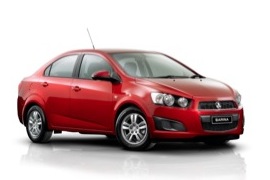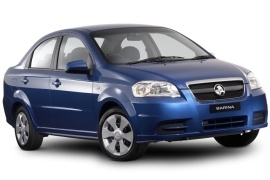HOLDEN Barina Sedan Models/Series Timeline, Specifications & Photos
First production year: 2006
Engines: Gasoline
After a few generations, when it used an Opel/Vauxhall platform for its smallest family member, Holden built the sixth generation of the Barina based on the Chevrolet Aveo sedan.
When GM bought the Daewoo remains, it also got a new platform that was almost ready to enter on the assembly lines. It was a small-segment vehicle, and the American carmaker used it for several markets. In Australia, it made it as the sixth generation of the Holden Barina. The four-door sedan was a decent choice for an urban environment.
The initial design was signed by Giorgetto Giugiaro and enhanced afterward by GM's styling department. Its three-box sedan shape was not part of the initial plan, but adding a trunk was not a bad idea for specific markets. In Australia, it was just another econobox on wheels. The Barina's front fascia featured four round headlights that formed an aggressive look together with the squared grille between them. On the bumper's lower side, the carmaker installed an additional grille. On the profile, the Barina featured sculptured door panels, with an ascending line that crossed both side doors towards the rear wheel-arches. At the back, the taillights were big compared with the car's overall size.
Inside, the Barina offered enough room for four adults or five if the rear ones didn't mind staying cramped. The instrument cluster carried over the same design as the Chevrolet spark, with a big dial for the tachometer and a side LCD for other information, including the speed. The trunk could host up to 502 liters (17.7 cu-ft) of luggage.
The engine ranged from a small, fuel-efficient 1.2-liter gasoline unit that offered 75 hp to a top version 1.6-liter displacement, which offered 115 hp. A 1.3-liter turbo-diesel in two power options was available as well.
GM built the Holden Barina sedan for the Australian market as a rebadged version of the European Chevrolet Aveo/Kalos sedan.
Daewoo developed the car before General Motors took it. It was just one of the projects that could have helped the Korean carmaker dodging the bankruptcy bullet, but it came too late. On the bright side, the American company found a way to use those projects in various countries, under different badges such as the Holden Barina, available in three styles: three and five doors hatchbacks or a four-door sedan.
Italdesign signed the car's look, and GM rushed to apply a "Design by Giugiaro" on the sides of the bodywork. With its big, angular headlights, the Barina tried to look more convincing, at least from the front. The raked-forward rear windscreen connected the greenhouse with the trunk area. At the same time, at the back, a set of triangular corner-mounted taillights with a clear horizontal lens for the reversing lights completed the car's image. It was an econobox, all right, but at least it looked decent.
Inside, the Barrina offered enough room for the front occupants, with regular seats and a few adjustments. It was cramped with virtually no legroom in the back, especially if the front occupants pushed their seats to the back. The simple dashboard design with four dials in a binocular styled instrument cluster offered enough information for the driver. A four-spoke steering wheel with three buttons for the audio system was on the options list.
Under the hood, GM offered the small-segment vehicle with three engine choices paired with a five-speed manual. Its main weakness was the result at the Asian NCAP crash-test, where the Barina managed just two stars.

